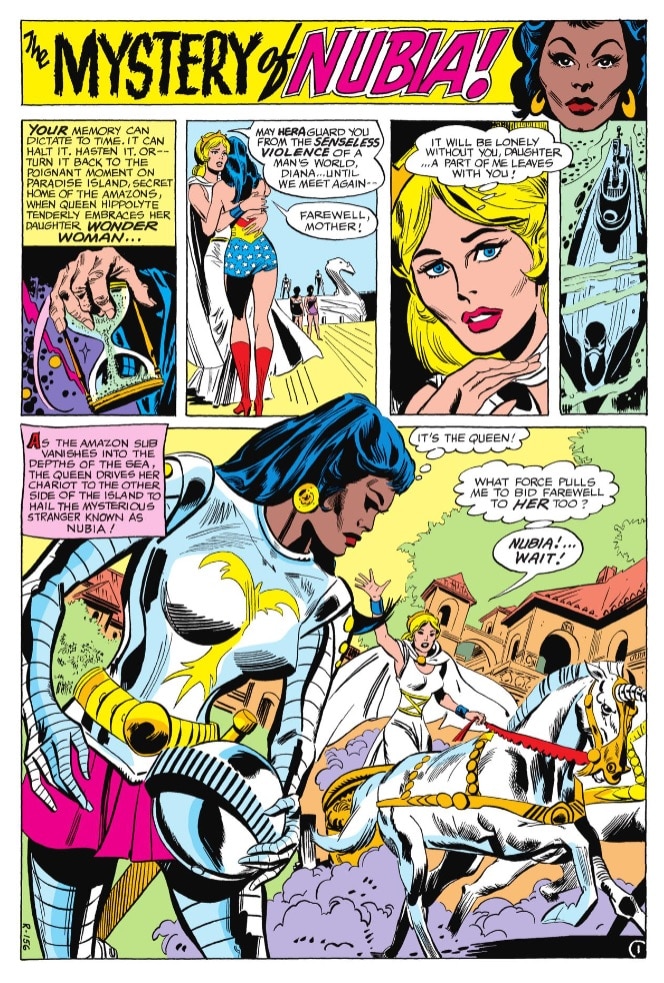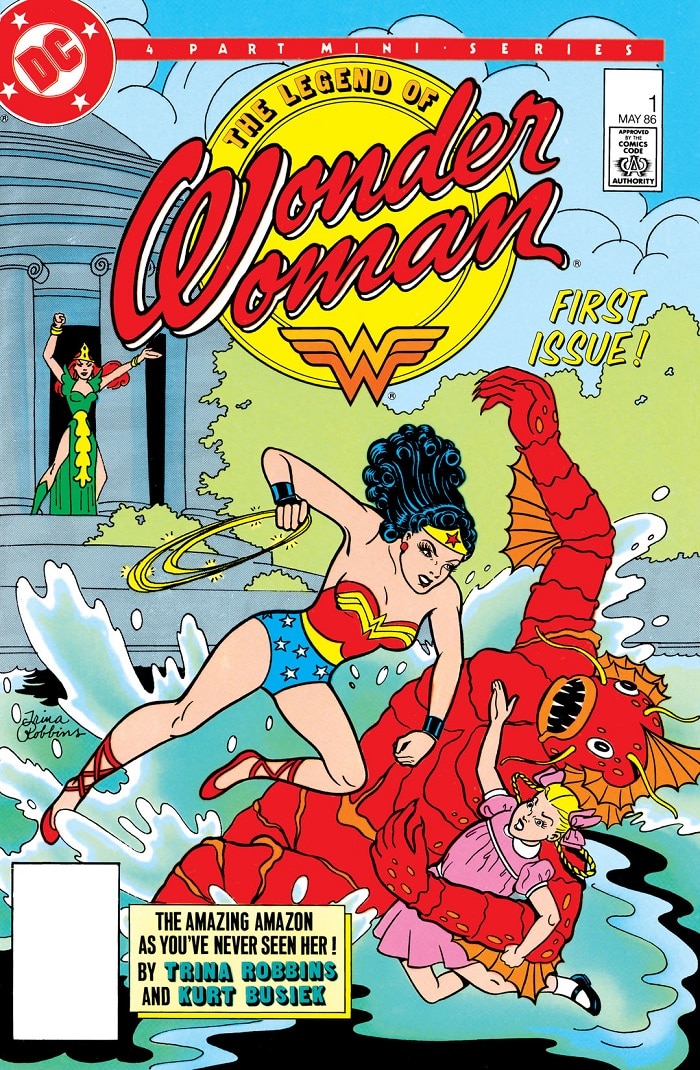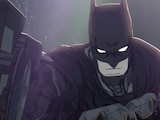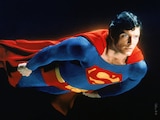It’s Wonder Woman Day, DC fans! This year, that day holds extra significance as we celebrate the 80th anniversary of All-Star Comics #8, when Princess Diana of Paradise Island first set foot upon “man’s world” to spread a message of truth and love. As we forge the future of the Amazons together in new titles like Nubia and the Amazons and the upcoming Wonder Woman: Trial of the Amazons crossover, now is a great time to look back at some of Diana’s greatest adventures. You may have heard the names George Perez, Greg Rucka, Gail Simone, Brian Azzarello, and even creator William M. Marston on other “best of” lists, but Diana’s unyielding mission doesn’t end with these legendary runs. As we look through her four-score history, here are some essential landmarks in Wonder Woman’s legacy you may have overlooked.
1940s: The First Woman on Wonder Woman

William Marston changed the face of comics forever in 1941, when he introduced the world to a hero who stood as a champion of truth like no other—and on top of that, she was a woman. But as Marston began to take ill in 1944, a writer was needed to cover for his duties covering the escapades of the Maid of Might. Enter 19-year-old Joye Hummel, an enterprising ghostwriter who became the second author of Wonder Woman and the first woman to write an ongoing title feature for what we now know as DC Comics.
In Wonder Woman #12-20, Joye told us wildly imaginative stories of the Amazons of the planet Venus, mischievous leprechauns in the hills of Ireland and a mission to prevent the horrifying specter of World War III. Though these stories were credited to Marston at the time, Hummel, who sadly passed away earlier this year, was recognized for her pioneering work in 2018 with the Bill Finger Award for Excellence in Comic Book Writing.
1950s: Diana’s First Flight

With over 2,600 stories to his name, Robert Kanigher still holds the title of the most prolific writer in the history of DC Comics. And for two historic decades, Kanigher presided over practically every Wonder Woman story published in what we recognize today as the Silver Age.
While Kanigher’s tenure on Wonder Woman can be traced as far back as 1947, the often difficult to delineate Silver Age for Wonder Woman didn’t truly begin until 1950’s Wonder Woman #98. In this issue, Kanigher reclaims Wonder Woman’s history by embellishing upon the nearly decade-old origin by Marston, and most significantly grants Wonder Woman the ability to fly—or at least, to glide on air currents like a bird of prey. If you watched with wonder as Diana took to the skies in Wonder Woman 1984, that first flight traces its origins to this 1950 issue.
1960s: The Impossible Tales

From the very beginning, Wonder Woman stories featured unique ideas you couldn’t find anywhere else in comics, but the ’60s is when they started to get downright weird. This is the period when Kanigher introduced us to the “Impossible Tales,” where Wonder Woman’s main supporting cast included Wonder Girl—herself, as a teenager—and Wonder Tot—herself, as a toddler. This trio of Diana, Diana and Diana traipsed around the world together in a series which was almost immediately cordoned off into its own separate continuity and labeled “Earth-124.1”. This curious chapter representing the height of Wonder Woman’s Pre-Crisis imaginative excess can be explored in Wonder Woman #124-158.
1970s: Introducing Nubia

Considered a footnote in Wonder Woman’s history for decades, Wonder Woman’s twin sister is having a long overdue moment as of late. As the star of her own Young Adult graphic novel in this year’s Nubia: Real One and the new Queen of Themyscira in Nubia and the Amazons #1, the once trivial Nubia is claiming a central role in Wonder Woman’s mythology. But that all started in 1976, in yet another Robert Kanigher story which brought some needed intersectionality into Wonder Woman’s feminist message. The story, told in Wonder Woman #204-206, still holds up today as one that introduces what should have been an essential Wonder Woman character from that point forward. Here’s hoping our prodigal sister sticks around a little while longer this time.
1980s: The Legend of Wonder Woman

For Wonder Woman fans, the 1980s are remembered as a time of new beginnings, with the historic Post-Crisis relaunch reacquainting Diana with a more modern world. But across the DC Universe, the ’80s are also remembered as a time of cataclysmic endings, as fifty years of history drew to a close, breaking upon the catastrophic events of Crisis on Infinite Earths. And just as Alan Moore’s “Whatever Happened to the Man of Tomorrow?” served as a coda to the many adventures of Superman before he’d come to be redefined in John Byrne’s Man of Steel, Trina Robbins and Kurt Busiek brought the weird and wild continuity of Wonder Woman to an apocalyptic end in the four issue Legend of Wonder Woman series.
Reflecting mainly on the early tales of Marston and Hummel in the pre-Kanigher years, The Legend of Wonder Woman was a celebration of the character’s roots before her entire world would be changed in the months to come. It’s a sort of epitaph to a Golden Age, wartime Wonder Woman who we thought we might never see again, and a project which does its best to bring closure to lifelong fans of the Amazon champion before ushering in a bold new era.
1990s: The Trinity

Superman. Batman. Wonder Woman. Today, “the Trinity” is regarded as the epicenter of the DC Universe—three pillars alike in scope and importance to the world of comics as a whole. But this “trinity” concept is newer than you might think.
The first instance of Wonder Woman acknowledging her importance as a DC Super Hero was in 1998’s Wonder Woman #140-141, where Diana stands alongside Batman and Superman for the first time outside of a Justice League setting to face…her rogue invisible jet.
Alright, this fill-in story by Eric Luke and Yanick Paquette is a bit of a footnote today, but it still stands as an early example of Diana’s contextualized importance next to the “World’s Finest.”
2000s: The Trinity

The concept of DC’s trinity didn’t fully take root until a decade later, in a story mostly defined by the three heroes’ absence: 2006’s 52, a year-long weekly event comic wherein the world must cope with the sudden absence of Batman, Superman and Wonder Woman.
One of several follow-ups to 52’s success was another 52-week series with the exact opposite premise: one which would explore the Trinity’s totemic importance to the very infrastructure of the universe. This series, appropriately called Trinity, was written by The Legend of Wonder Woman’s Kurt Busiek with the highest of ambitions, portraying each member of the trio as a modern-day god. A sort of epic poem of a series, Trinity dedicates a third of its space to defining Wonder Woman’s integrity in a way that we’ve seen acknowledged again only recently for her prominent role in Dark Nights: Death Metal as the light that vanquished the Dark Multiverse.
2010s: The Legend of Wonder Woman

The past decade has been an eventful one for every flavor of Wonder Woman fan. The painfully gorgeous art of Cliff Chiang’s New 52 Greek epic, the redefinition of her values from Rucka, Liam Sharp and Nicola Scott, the long-awaited Earth One treatment from Grant Morrison and Yanick Paquette, Jill Thompson’s Eisner-winning Wonder Woman: The True Amazon, and even her live-action cinematic debut. But one of the most exceptional Wonder Woman tales of the past ten years was a digital-first series by Renae de Liz and Ray Dillon, in a new attempt to recapture the magic of Diana’s World War II origins.
Appropriately titled The Legend of Wonder Woman, harkening back to the work of Robbins and Busiek, this too-short-lived series revisited Wonder Woman’s first stories with modern storytelling sensibilities. With its lavish cartoon style and captivating scene building, this Legend of Wonder Woman is one of the finest entry points you can offer to the Wonder-curious fan without messing about with decades of continuity.
And just like everything on this list…you can read it for yourself on DC UNIVERSE INFINITE! So treat yourself this Wonder Woman Day with a dive into the less-swum lakes of Themyscira. We guarantee a rare experience to leave you filled with wonder.
Shop, read and dive into the world of Diana of Themyscira on our special Wonder Woman 80th Anniversary page!
Alex Jaffe is the author of our monthly "Ask the Question" column and writes about TV, movies, comics and superhero history for DCComics.com. Follow him on Twitter at @AlexJaffe and find him in the DC Community as HubCityQuestion.




















